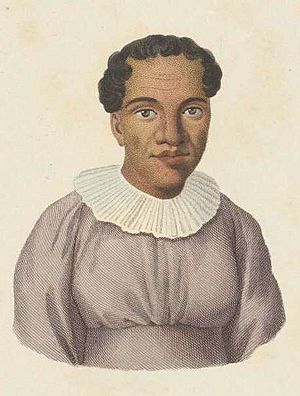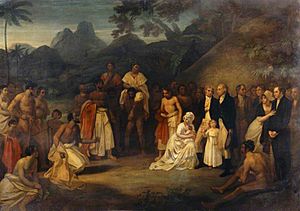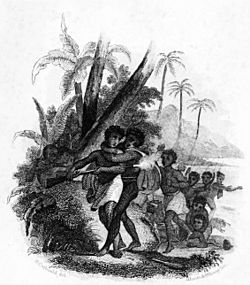Teriitaria II facts for kids
Quick facts for kids Teriitaria II |
|
|---|---|
| Queen regnant of Huahine and Mai’ao Queen and Regent of Tahiti |
|

Portrait by Jules-Louis Lejeune, c. 1826
|
|
| Queen regnant of Huahine and Mai’ao | |
| Reign | 1815–1852/1854 |
| Predecessor | Mahine Tehei'ura |
| Successor | Ari'imate (eventual) |
| Born | c. 1790 |
| Died | 1858 (aged 67–68) Papeete, Tahiti |
| Spouse | Pōmare II |
| House | House of Tamatoa |
| Father | Tamatoa III |
| Mother | Tura’iari’i Ehevahine |
| Religion | Tahitian later Protestant |
Teriitaria II, also known as Pōmare Vahine and Ari'ipaea Vahine, was born around 1790 and died in 1858. She became Queen of Tahiti when she married King Pōmare II. Later, she ruled as Queen of Huahine and Maiao in the Society Islands.
Teriitaria was the oldest child of King Tamatoa III of Raiatea. Her mother, Tura’iari’i Ehevahine, was from the royal family of Huahine. In 1809, Teriitaria and her sister, Teriʻitoʻoterai Teremoemoe, married their cousin, Pōmare II of Tahiti.
Teriitaria became Queen of Huahine in 1815. She fought in the Battle of Te Feipī in 1815, which helped her husband keep his rule. She had no children with Pōmare II. However, Pōmare had two children with her sister Teremoemoe: Pōmare III and Pōmare IV.
After Pōmare II died in 1821, Teriitaria and Teremoemoe became regents for the young King Pōmare III. After his death in 1827, they continued as regents for Pōmare IV. Teriitaria was removed from the regency in 1828 but remained important in Tahiti. She led Tahitian forces in a rebellion in 1832.
During the Franco-Tahitian War (1844–1847), she went into exile with her niece, Pōmare IV. In 1846, Teriitaria bravely fought off a French invasion at the Battle of Maeva. This battle helped keep the Leeward Islands independent. She was removed from her rule in Huahine around 1852 or 1854. She died in 1858 in Papeete, Tahiti.
Contents
Queen Teriitaria II
Early Life and Family
The Tamatoa family, to which Teriitaria II belonged, was a very important family of chiefs. They were connected to the royal families of other Society Islands like Tahiti, Moorea, Huahine, Maiao, Tahaa, Bora Bora, and Maupiti. Raiatea, with its famous Taputapuatea marae temple, was seen as a religious center for the region.
Teriitaria was born around 1790. As the oldest daughter, she had a special place in society. In Tahitian culture, important titles could be passed down through the first-born daughters. Her father was Tamatoa III, the King of Raiatea. The ariʻi were the ruling class in Tahitian society. They held both political and religious power.
Her mother was Tura’iari’i Ehevahine. She was the daughter of Queen Tehaʻapapa I of Huahine. Queen Tehaʻapapa I was ruling when Captain James Cook visited the Society Islands in 1769. Teriitaria had younger siblings, including a brother named Tamatoa IV and sisters Teriʻitoʻoterai Teremoemoe, Temari'i Ma'ihara, and Teihotu Ta'avea.
Tahitian names often had meanings related to land and titles. The name Teri'i means "sovereign" or "chief." So, Teri'itari'a meant "Carried-sovereign." The name Ari'ipaea, which she used later, meant "Sovereign-reserved." Pōmare, a name she took after marriage, meant "night cougher," and Vahine meant "woman."
Marriage and Royal Role

In the late 1700s, Pōmare I created the Kingdom of Tahiti. He did this by uniting traditional titles and using Western weapons from explorers like Captain Cook. Protestant missionaries from the London Missionary Society (LMS) arrived in 1797. They settled in Matavai Bay under Pōmare I's protection.
However, his son, Pōmare II, faced challenges. Local chiefs rebelled against him and the missionaries. By 1808, Pōmare II and his followers had to flee to the island of Moorea.
Pōmare II's first wife had no children. To strengthen his power, Pōmare II's mother wanted to form an alliance with the important Tamatoa family of Raiatea. This alliance was also important for the exiled king, who needed military help to win back Tahiti.
Around 1809, Pōmare II married both Teriitaria and her younger sister, Teriʻitoʻoterai Teremoemoe. Some sources say the marriage happened around November 8, 1811. Even though Pōmare II preferred her younger sister, Teriitaria was given the status of queen and the honorary title of Pōmare Vahine. Teriitaria's marriage to Pōmare II had no children. Her sister Teremoemoe had three children with him, including Aimata (who became Queen Pōmare IV) and Teriitaria (who became King Pōmare III). The elder Teriitaria was seen as the adoptive mother of young Pōmare III.
Leading Battles and Changes
While in exile, Pōmare II started to rely more on the Christian missionaries. In 1812, he publicly announced he had become a Christian. Unlike his father, Pōmare II was not a warrior. He often let his wives lead the fighting. Teriitaria supported her husband's armies in taking back Tahiti and bringing Christianity to the island. She was known as a brave and strong woman who personally led warriors into battle.
In May 1815, Teriitaria and Teremoemoe visited a district in Tahiti. Local chiefs who followed the traditional religion plotted to attack them and the new Christians. On July 7, Teriitaria and her group barely escaped the attack. They fled by canoe back to Moorea.
In September 1815, Pōmare II's forces returned to Tahiti. They wanted to take back control from the traditionalists. Teriitaria led the Christian warriors, fighting alongside Mahine, the king of Huahine and Maiao. The two sides met on November 11, 1815, at the Battle of Te Feipī. The battle ended when the traditionalist leader was killed. Pōmare's side won a major victory, and they took back control of Tahiti.
After this battle, many Tahitians left their old religion and became Christians. King Pōmare II ordered the destruction of traditional temples and idols. New churches began to be built. Teriitaria and Teremoemoe had already converted to Christianity. In 1817, Pōmare II wrote that his wife Tarutaria (Teriitaria) was very ill, but she survived.
Pōmare II was officially baptized on July 16, 1819. He was the first Tahitian to be baptized. Other members of the royal family, including Teriitaria and her sister, were baptized on September 10, 1820. Teriitaria was later allowed to take part in the Eucharist, a Christian ceremony, because she was seen as "more correct in her conducts, and more amiable in her manner."
Regent and Ruler
After Pōmare II died in 1821, his young son, Teriitaria, became King Pōmare III of Tahiti. Since he was a child, a group of regents was formed to rule for him. This council included his aunt Teriitaria, his mother Teremoemoe, and five main chiefs. Teriitaria eventually became the head of this regency council.
On September 6, 1826, Queen regent Teriitaria and Pōmare III signed a treaty with the United States. This treaty set up trade between the two nations. The British missionaries did not like this because Britain did not have a formal treaty with Tahiti.
The regency council continued until Pōmare III died in 1827. Teriitaria then continued as regent for her niece, Aimata, who became Queen Pōmare IV. Teriitaria's rule was seen as difficult for European traders. She tried to control the pearl trade and ignored piracy. She also set fixed prices and wages, which upset both Tahitians and foreign merchants. Because of these problems, she was replaced as regent in April 1828 by a chief named Tati. In the 1830s, she took the title Ari'ipaea Vahine.
Even after being removed as regent, Teriitaria still had a lot of power. She was second in rank only to her niece, the Queen. In February 1832, Teriitaria, along with Tati and other chiefs, led Queen Pōmare IV's forces to stop a rebellion. This rebellion was supported by a religious movement that mixed Christianity with old beliefs. Teriitaria personally led her warriors in battle, holding a sword and pistol. The battle on February 12 was a big win for the Queen's forces and ended the rebellion.
Defending Huahine
In 1815, Teriitaria became the Queen of Huahine and Maiao. The previous ruler, Mahine, had fought with her at the Battle of Te Feipī. Mahine later formally gave the government of the islands to her. For the first few decades, she ruled Huahine from Tahiti, where she lived.
Her later rule happened during the Franco-Tahitian War. In 1843, French forces tried to take over Tahiti and removed Queen Pōmare IV. From 1844 to 1847, Teriitaria went into exile with her niece in Raiatea to protest the French takeover.
In 1845, she stopped the French from trying to control the independent Leeward Islands (Bora Bora, Raiatea, and Huahine). The French had put their flag on Huahine. Teriitaria, while on Raiatea, heard about this. She gathered warriors and sailed to Huahine. She gathered the people and had them cut down the flagpole. She then pulled it out herself and sent the flag back to the French governor of Tahiti.
The French tried again to conquer Huahine. On January 17, 1846, 400 French soldiers landed at Fare harbor. During the Battle of Maeva, Teriitaria’s forces, with some European support, fought off the French for two days. They caused many casualties before the French gave up and sailed away. A British merchant noted that "Old Ariipae, musket in hand... was there to encourage her people." This victory stopped the French naval blockade and helped free the Leeward Islands.
Although Britain did not send troops, a British naval officer, Henry Byam Martin, visited the islands to observe the conflict. He met Teriitaria on April 21, 1847. She told him, "I would resist the French flag to the last."
The French stopped trying to conquer the Leeward Islands after this. In February 1847, Queen Pōmare IV returned from exile and agreed to rule under French protection. However, the French could not fully take over the islands because of pressure from Great Britain. France and Great Britain signed an agreement, the Jarnac Convention, to respect the independence of Huahine, Raiatea, and Bora Bora.
Teriitaria did not trust the French and refused to return to Papeete with her niece in 1847. She wrote a letter to Queen Victoria asking her to protect the independence of the Leeward Islands. To show the strong connection between the royal families of the Society Islands, Teriitaria adopted Queen Pōmare IV's second son, Terātane, as her heir to the throne of Huahine. This boy would later become King Pōmare V.
Later Life and Challenges
Around 1852 or 1854, Teriitaria was removed from her rule over Huahine. The exact details of how power changed hands are not fully clear to historians.
A civil war broke out in October 1852 on Huahine. This happened after an incident in 1850 where her followers destroyed property belonging to a European trader. Teriitaria was forced to pay a large amount of money as a result. She was removed from power by Ari'imate (1824–1874), who was Mahine's grandson. In 1853, she tried to get her throne back by allying with the French commander in Tahiti, but she was not successful.
One historical account says that Teriitaria was overthrown after a battle with Ari'imate on March 18, 1854. Another account from a French naval doctor noted that "Terii-Taria, old queen of Huahine who, left without posterity, was dethroned not long ago to make room for one of her nephews." Ari'imate later married her niece, who became Queen Tehaʻapapa II in 1868.
A British missionary named John Barff suggested that Teriitaria's removal was due to changes in traditional power. The common people were unhappy with the chiefs taking food from their farms whenever they wanted.
Teriitaria died in Papeete in 1858. She passed away at the royal palace, with her sister and niece by her side.
Family tree
|
|||||||||||||||||||||||||||||||||||||||||||||||||||||||||||||||||||||||||||||||||||||||||||||||||||||||||||||||||||||||||||||||||||||||||||||||||||||||||||||||||||||||||||||||||||||||||||||||||||||||||||||||||||||||||||||||||||||||||||||||||||||||||||||||||||||||||||||||||||||||||||||||||||||||||||||||||||||||||||||||||||||||||||||||||||||||||||||||||||||||||||||||||||||||||||||||||||||||||||||||||||||||||||||||||||||||||||||||||||||||||||||||||||||||||||||||||||||||||||||||||||||||||||||||||||||||||||||||||||||||||||||||||||||||||||||||||||||||||||||||||||||||||||||||||||||||||||||||||||||||||||||||||||||||||||||||||||||||||||||||||||||||||||||||||||||||||||||||||||||||||||||||||||||||||||||||||||||||||||||||||||||||||||||||||||||||||||||||||||||||||||||||||||||||||||||||||||||||||||||||||||||||||||||||||||||||||||||||||||||||||||||||||||||||||||||||||||||||||||||||||||||||||||||||||||||||||||||||||||||||||||||||||||||||||||||||||||||||||||||||||||||||||||||||||||||||||||||||||||||||
| Notes:
The numbering of the Tamatoa varies. An ancestor of the Tamatoa line named Fa'aniti is often counted as "Tamatoa I" and Moeore is not consider Tamatoa IV.
|
|||||||||||||||||||||||||||||||||||||||||||||||||||||||||||||||||||||||||||||||||||||||||||||||||||||||||||||||||||||||||||||||||||||||||||||||||||||||||||||||||||||||||||||||||||||||||||||||||||||||||||||||||||||||||||||||||||||||||||||||||||||||||||||||||||||||||||||||||||||||||||||||||||||||||||||||||||||||||||||||||||||||||||||||||||||||||||||||||||||||||||||||||||||||||||||||||||||||||||||||||||||||||||||||||||||||||||||||||||||||||||||||||||||||||||||||||||||||||||||||||||||||||||||||||||||||||||||||||||||||||||||||||||||||||||||||||||||||||||||||||||||||||||||||||||||||||||||||||||||||||||||||||||||||||||||||||||||||||||||||||||||||||||||||||||||||||||||||||||||||||||||||||||||||||||||||||||||||||||||||||||||||||||||||||||||||||||||||||||||||||||||||||||||||||||||||||||||||||||||||||||||||||||||||||||||||||||||||||||||||||||||||||||||||||||||||||||||||||||||||||||||||||||||||||||||||||||||||||||||||||||||||||||||||||||||||||||||||||||||||||||||||||||||||||||||||||||||||||||||||
|
||||||||||||||||||||||||||||||||||||||||||||||||||||||||||||||||||||||||||||||||||||||||||||||||||||||||||||||||||||||||||||||||||||||||||||||||||||||||||||||||||||||||||||||||||||||||||||||||||||||||||||||||||||||||||||||||||||||||||||||||||||||||||||||||||||||||||||||||||||||||||||||||||||||||||||||||||||||||||||||||||||||||||||||||||||||||||||||||||||||||||||||||||||||||||||||||||||||||||||||||||||||||||||||||||||||||||||||||||||||||||||||||||||||||||||||||||||||||||||||||||||||||||||||||||||||||||||||||||||||||||||||||||||||||||||||||||||||||||||||||||||||||||||||||||||||||||||||||||||||||||||||||||||||||||||||||||||||||||||||||||||||||||||||||||||||||||||||||||||||||||||||||||||||||||||||||||||||||||||||||||||||||||||||||||||||||||||||||||||||||||||||||||||||||||||||||||||||||||||||||||||||||||||||||||||||||||||||||||||||||||||||||
| Notes:
Descending dotted lines denote adoptions.
|
||||||||||||||||||||||||||||||||||||||||||||||||||||||||||||||||||||||||||||||||||||||||||||||||||||||||||||||||||||||||||||||||||||||||||||||||||||||||||||||||||||||||||||||||||||||||||||||||||||||||||||||||||||||||||||||||||||||||||||||||||||||||||||||||||||||||||||||||||||||||||||||||||||||||||||||||||||||||||||||||||||||||||||||||||||||||||||||||||||||||||||||||||||||||||||||||||||||||||||||||||||||||||||||||||||||||||||||||||||||||||||||||||||||||||||||||||||||||||||||||||||||||||||||||||||||||||||||||||||||||||||||||||||||||||||||||||||||||||||||||||||||||||||||||||||||||||||||||||||||||||||||||||||||||||||||||||||||||||||||||||||||||||||||||||||||||||||||||||||||||||||||||||||||||||||||||||||||||||||||||||||||||||||||||||||||||||||||||||||||||||||||||||||||||||||||||||||||||||||||||||||||||||||||||||||||||||||||||||||||||||||||||
|
|||||||||||||||||||||||||||||||||||||||||||||||||||||||||||||||||||||||||||||||||||||||||||||||||||||||||||||||||||||||||||||||||||||||||||||||||||||||||||||||||||||||||||||||||||||||||||||||||||||||||||||||||||||||||||||||||||||||||||||||||||||||||||||||||||||||||||||||||||||||||||||||||||||||||||||||||||||||||||||||||||||||||||||||||||||||||||||||||||||||||||||||||||||||||||||||||||||||||||||||||||||||||||||||||||||||||||||||||||||||||||||||||||||||||||||||||||||||||||||||||||||||||||||||||||||||||||||||||||||||||||||||||||||||||||||||||||||||||||||||||||||||||||||||||||||||||||||||||||||||||||||||||||||||||||||||||||||||||||||||||||||||||||||||||||||||||||||||||||||||||||||||||||||||||||||||||||||||||||||||||||||||||||||||||||||||||||||||||||||||||||||||||||||||||||||||||||||||||||||||||||||||||||||||||||||||||||||||||||||||||||||||||||||||||||||||||||||||||||||||||||||||||||||||||||||||||||||||||||||||||||||||||||||||||||||||||||||||||||||||||||||||||||||||||||||||||||||||||||||||
| Notes:
Descending dotted lines denote adoptions.
|
|||||||||||||||||||||||||||||||||||||||||||||||||||||||||||||||||||||||||||||||||||||||||||||||||||||||||||||||||||||||||||||||||||||||||||||||||||||||||||||||||||||||||||||||||||||||||||||||||||||||||||||||||||||||||||||||||||||||||||||||||||||||||||||||||||||||||||||||||||||||||||||||||||||||||||||||||||||||||||||||||||||||||||||||||||||||||||||||||||||||||||||||||||||||||||||||||||||||||||||||||||||||||||||||||||||||||||||||||||||||||||||||||||||||||||||||||||||||||||||||||||||||||||||||||||||||||||||||||||||||||||||||||||||||||||||||||||||||||||||||||||||||||||||||||||||||||||||||||||||||||||||||||||||||||||||||||||||||||||||||||||||||||||||||||||||||||||||||||||||||||||||||||||||||||||||||||||||||||||||||||||||||||||||||||||||||||||||||||||||||||||||||||||||||||||||||||||||||||||||||||||||||||||||||||||||||||||||||||||||||||||||||||||||||||||||||||||||||||||||||||||||||||||||||||||||||||||||||||||||||||||||||||||||||||||||||||||||||||||||||||||||||||||||||||||||||||||||||||||||||
See also
 In Spanish: Teri'itaria II para niños
In Spanish: Teri'itaria II para niños
- List of monarchs of Huahine
- List of consorts of Tahiti





